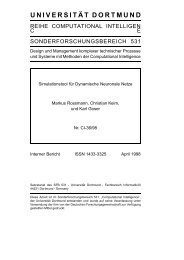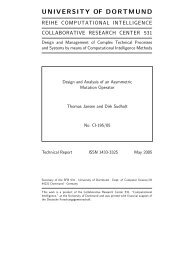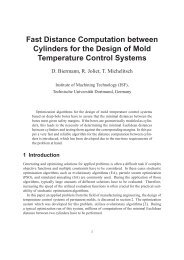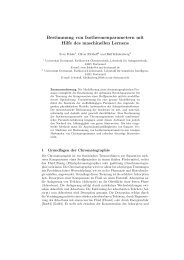Self-Adaptive Genetic Algorithms with Simulated Binary Crossover
Self-Adaptive Genetic Algorithms with Simulated Binary Crossover
Self-Adaptive Genetic Algorithms with Simulated Binary Crossover
You also want an ePaper? Increase the reach of your titles
YUMPU automatically turns print PDFs into web optimized ePapers that Google loves.
2. Other probability distributions, such as lognormal probability distribution, can also be investigated<br />
for self-adaptive behavior in real-parameter GAs.<br />
3. Other existing real-parameter crossover operators can be investigated for their self-adaptive behavior.<br />
4. Properties for an efficient crossover operator can be developed for real-parameter GAs.<br />
5. A generic real-parameter crossover operator <strong>with</strong> more than two parents can be investigated for a<br />
faster progress rate.<br />
6. A real-parameter crossover efficient for problems having correlated interactions among object variables<br />
can be investigated.<br />
7. Real-parameter GAs can be compared <strong>with</strong> self-adaptive ESs in real-world complex search and<br />
optimization problems.<br />
8. Properties for an algorithm to exhibit self-adaptation and test suites can be developed for testing<br />
self-adaptive feature of an algorithm.<br />
9. Discrete programming <strong>with</strong> real-parameter GAs <strong>with</strong> a modified SBX operator can be investigated<br />
for self-adaptation.<br />
2!;>0:<br />
We discuss the above extensions in somewhat more details.<br />
In this study, we have shown that the real-parameter GAs <strong>with</strong> SBX operator has the self-adaptive<br />
behavior, similar to that in a self-adaptive ES <strong>with</strong> lognormal update of self-adaptive parameters. Other<br />
self-adaptive ES implementations also exist and it will be interesting to compare the performance of realparameter<br />
GAs <strong>with</strong> SBX operator <strong>with</strong> them. Of them, the ES implementations by Hansen and Ostermier<br />
(1995) can be investigated.<br />
It is intuitive that there is nothing special about the polynomial probability distribution used in the SBX<br />
operator. However, it is important that the properties of the SBX operator described in section 2 must be<br />
preserved in a probability distribution for crossover. Thus, other more standard probability distributions<br />
used in ES, such as lognormal distributioncan be used. In this regard, the following probability distribution<br />
as a function of can be investigated, instead of equation 3:<br />
(25)<br />
This probability distribution has its mode (maximum) at=exp(?2), mean at=exp(2=2), and<br />
exactly 50% probability of finding a01. The above<br />
distribution has a variance2=exp(2)(exp(2)?1). Since all statistical properties for this distribution<br />
are known, it may be easier to compare the performance of such crossover operators <strong>with</strong> self-adaptive ES<br />
which also uses lognormal update rule.<br />
Besides the SBX operator, there exist other real-parameter crossover operators such as BLX- (Eshelman<br />
and Schaffer, 1992) and UNDX operators (Ono and Kobayashi, 1997) which can be investigated for<br />
self-adaptive behavior. We have investigated BLX-0.5 operator in some test problems in this study and<br />
our findings are not positive. However, BLX- <strong>with</strong> other values can be tried for their self-adaptive<br />
behavior. The UNDX operator creates children solutions proportional to the parent solutions, but gives<br />
preference to solutions that are near the mean of the parent solutions. This property is contrary to what<br />
SBX operator does, and it will be an interesting study to investigate whether real-parameter GAs <strong>with</strong> the<br />
UNDX operator has the adequate self-adaptive behavior.<br />
Studies of self-adaptation <strong>with</strong> various real-parameter crossover operators will reveal and allow us to<br />
find properties which are needed in an efficient real-parameter crossover operator. Such properties will<br />
P()=1 p21exp ?12(ln)2<br />
20








